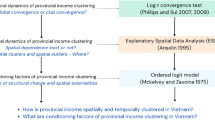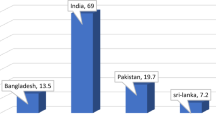Abstract
The USA is the largest source country of worldwide remittances. This paper is the first to use Current Population Survey data to estimate the determinants of remittances originating from the USA for a diverse set of approximately 3800 households with at least one foreign-born worker. We employ a gravity model examining the role of various push, pull, and distance factors. Most notably, higher household earnings push monetary transfers abroad: We estimate an average earnings elasticity in the range of 0.20–0.30. Remittances are more responsive to earnings in households with more adult women relative to men.


Similar content being viewed by others
Notes
See McCracken et al. (2017) for a similar approach.
Note that many of these studies report average remittance levels as a share of income, not proportional changes in remittances due to percentage increases in income. Therefore, coefficients from these studies cannot be directly interpreted as elasticities.
We also drop three observations with average weekly household earnings that are more than 10 standard deviations away from the mean.
We follow the approach motivated by Borjas (2017) to define likely undocumented immigrants using CPS data. They include all non-naturalized foreign-born workers that entered the USA since 1980, do not work in the military or the government, are not from Cuba, are not a college student, and are not a spouse of a legal resident.
US regions are defined in Fairchild and Simpson (2008).
We do not display the comparison of the CPS with the ACS since our analysis is at the household level. Details are available from the authors upon request.
Few households originate from a single country. Two-thirds of the households in our sample include some members born in a foreign country and others born in the USA, while 11% of the remaining observations have members born in multiple foreign countries. Therefore, we account for origin-country economic conditions with a single variable measuring the average GDP of all foreign-born household members’ birth countries.
Birthplace diversity forces us to use average distance to members’ origin countries just as with the average GDP calculation. Country indicators, in contrast, measure whether any member was born in Mexico or Canada.
Within-household birthplace diversity prevents clustering at the country level. Moreover, evidence in Abadie et al. (2017) suggests that geographic clustering may be inappropriate in this setting – and might lead to standard errors that are too conservative—since there is no apparent design problem in the data for clustering to correct.
A detailed discussion of the two-part and Heckman models in an immigration context in which the dependent variable frequently takes on zero values can be found in Simpson and Sparber (2013).
Sinning (2011) documents how the relationship between household size and remittances depends on whether family members are in the destination or source country. The CPS does not ask detailed information about other family members in the home country so we have to focus on household members in the USA.
For this reason, other collections of variables summing to household size – such as the push factors discussed above – must omit one reference group to avoid perfect collinearity.
For brevity, we do not include the full set of regression results, but they are available upon request from the authors.
Note that the horizontal axis is not the strict difference between women and men in the household since, for example, a household with more than two men and more than two women would record a difference value of zero regardless of how many men and women actually reside in the home. A similar if less dramatic story emerges if we instead calculate separate elasticities according to the number of employed women and men in the household.
References
Abadie, Alberto, Susan Athey, Guido W. 2017. Imbens, and Jeffrey Wooldridge. “ When Should You Adjust Standard Errors for Clustering?.” NBER Working Paper 24003.
Amuedo-Dorantes, Catalina, Cynthia Bansak, and Susan Pozo. 2005. On the Remitting Patterns of Immigrants: Evidence from Mexican Survey Data. Economic Review 90(1): 37–58.
Amuedo-Dorantes, Catalina, and Susan Pozo. 2005. On the Use of Differing Money Transmission Methods by Mexican Immigrants. International Migration Review 39(3): 554–576.
Amuedo-Dorantes, Catalina, and Susan Pozo. 2006. Remittances and Insurance: Evidence from Mexican Migrants. Journal of Population Economics 19(2): 227–254.
Amuedo-Dorantes, Catalina, and Susan Pozo. 2011. Remittances and Income Smoothing. American Economic Review 101(3): 582–87.
Arun, Thankom, and Hulya Ulku. 2011. Determinants of Remittances: The Case of the South Asian Community in Manchester. Journal of Development Studies 47(6): 894–912.
Bai, Helen, and Mai-Chi Hoang. 2010. Annual Revision of the U.S. International Transactions Accounts. Survey of Current Business 90: 36–50.
Bedi, Arjun, Carla Calero, and Robert Sparrow. 2008. Remittances, Liquidity Constraints and Human Capital Investments in Ecuador. World Development 37(6): 1143–1154.
Borjas, George. 2017. The Labor Supply of Undocumented Immigrants. Labour Economics 46: 1–13.
Buch, Claudia M., and Anja Kuckulenz. 2009. Worker Remittances and Capital Flows to Developing Countries. International Migration 48(5): 89–117.
Chowdhury, Murshed, and Anupam Das. 2016. Remittance Behaviour of Chinese and Indian Immigrants in Canada. Review of Economics 67(2): 185–208.
Clemens, Michael A., and Jennifer Hunt. 2017. The Labor Market Effects of Refugee Waves: Reconciling Conflicting Results. ILR Review 72(4): 816–857.
de la Cruz, G. Patricia and Cassandra Logan. 2013. “ 2008 CPS Immigration/Emigration Supplement Debriefing Report.” Population Division Working Paper No. 99, U.S. Census Bureau, Washington, D.C. 20233. April.
Durand, Jorge, William Kandel, Emilio A. Parrado, and Douglas S. Massey. 1996. International Migration and Development in Mexican Communities. Demography 33: 249–64.
Fairchild, Stephen, and Nicole B. Simpson. 2008. Comparison of Mexican Migrant Remittances Across U.S. Regions. Contemporary Economic Policy 26(3): 360–379.
Frankel, Jeffrey A. 2011. Are Bilateral Remittances Countercyclical? Open Economies Review 22: 1–16.
Grieco, Elizabeth M., de la Cruz, Patricia, Rachel Cortes, and Luke Larsen. 2009. “ Who in the United States sends and receives remittances? An initial analysis of the monetary transfers data from the August 2008 CPS Migration Supplement.” Population Division, Working Paper No. 87.
Glytsos, Nicholas. 2001. “ Determinants and effects of migrant remittances: A survey,” pp. In International Migration: Trends, Policies, and Economic Impact, ed. S. Djajic, 250–268. London: Routledge.
Havolli, Sokol. 2011.“ Determinants of Migrants Earnings and Remittances: Evidence from Kosovo.” Available at SSRN: https://ssrn.com/abstract=1829998.
Lucas, Robert, and Oded Stark. 1985. Motivations to Remit: Evidence from Botswana. Journal of Political Economy 93(5): 901–918.
Lueth, Erik, and Marta Ruiz-Arranz. 2008. Determinants of Bilateral Remittance Flows. Journal of Macroeconomics 8: 1–21.
Mandelman, Federico S., and Andrei Zlate. 2012. Immigration, Remittances and Business Cycles. Journal of Monetary Economics 59(2): 196–213.
Markova, Eugenia, and Barry Reilly. 2007. Bulgarian Migrant Remittances and Legal Status: Some Micro-Level Evidence from Madrid. South-Eastern Europe Journal of Economics 5(1): 55–69.
Merkle, Lucie, and Klaus F. Zimmermann. 1992. Savings, Remittances and Return Migration. Economic Letters 38: 77–81.
McCracken, Scott, Carlyn Ramlogan-Dobson, and Marie M. Stack. 2017. A Gravity Model of Remittance Determinants: Evidence from Latin America and the Caribbean. Regional Studies 51(5): 737–749.
National Bureau of Economic Research (NBER). 2019. NBER CPS Supplements. Available at: https://www.nber.org/data/current-population-survey-data.html. Accessed 10 Jan 2019.
Niimi, Yoko, Caglar Ozden, and Maruice Schiff. 2010. Remittances and the Brain Drain: Skilled Migrants Do Remit Less. Annals of Economics and Statistics/Annales dconomie et de Statistique 97(8): 123–141.
Rosenzweig, Mark R., and Oded Stark. 1989. Consumption Smoothing, Migration, and Marriage: Evidence from Rural India. Journal of Political Economy 97(4): 905–926.
Sana, Mariano. 2005. Buying Membership in the Transnational Community: Migrant Remittances, Social Status, and Assimilation. Population Research and Policy Review 24: 231–61.
Simpson, Nicole B., and Chad Sparber. 2013. The Short- and Long-Run Determinants of Less-Educated Immigrant Flows into US States. Southern Economic Journal 80(2): 414–438.
Sinning, Mathias G. 2011. Determinants of Savings and Remittances: Empirical Evidence from Immigrants to Germany. Review of Economics of the Household 9(1): 45–67.
Stark, Oded. 1991. The Migration of Labour. Oxford: Basil Blackwell.
Straubhar, Thomas and Florin P. Vadean, 2005. “ Introduction: International migrant remittances and their role in development.” In: OECD (Ed.), Migration, remittances and development. OECD Publishing, Paris, 1333.
Unheim, Per, and Dane Rowlands. 2012. Micro-Level Determinants of Remittances from Recent Migrants to Canada. International Migration 50(4): 124–139.
Yang, Dean. 2008. International Migration, Remittances, and Household Investment: Evidence from Philippine Migrants Exchange Rate Shocks. Economic Journal 118(528): 591–630.
Yang, Dean. 2011. Migrant Remittances. Journal of Economic Perspectives 25(2): 129–52.
Author information
Authors and Affiliations
Corresponding author
Additional information
Publisher's Note
Springer Nature remains neutral with regard to jurisdictional claims in published maps and institutional affiliations.
The authors would like to thank Carolina Castilla, Michael O’Hara, Cynthia Bansak, Kelsey O’Connor, two anonymous referees, and session participants at the EEA Conference (NYC) in March 2019 for their helpful comments.
Rights and permissions
About this article
Cite this article
Simpson, N.B., Sparber, C. Estimating the Determinants of Remittances Originating from US Households Using CPS Data. Eastern Econ J 46, 161–189 (2020). https://doi.org/10.1057/s41302-019-00155-2
Published:
Issue Date:
DOI: https://doi.org/10.1057/s41302-019-00155-2




